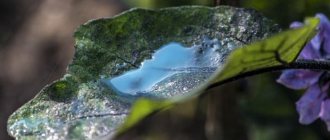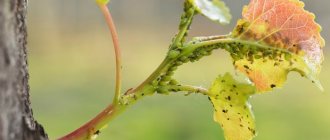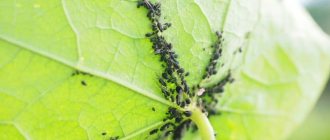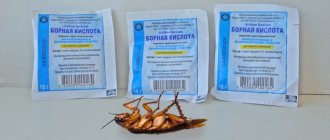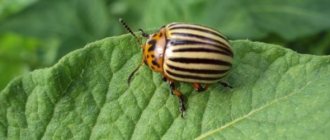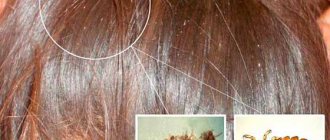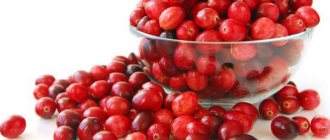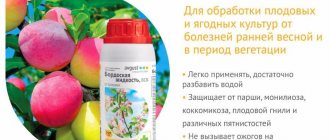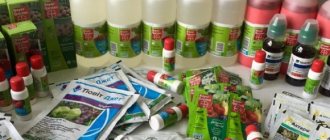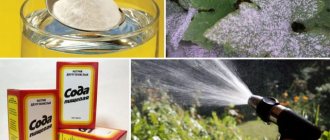Origin of Bordeaux mixture and chemical composition
Bordeaux mixture is named after the French province of Bordeaux, where the creator of this product, the outstanding chemist of the early 19th century Joseph Louis Proust, worked and died.
How did Proust come up with the Bordeaux mixture (click to expand)
It is curious that Proust did not set himself the task of obtaining a fungicide. He developed his famous blend for local winegrowers when they asked him to come up with something to keep thieves away from their vineyards. Proust's liquid, which after drying looked like mold on the grapes, coped with this problem.
Several decades later, an academician of the French Academy of Sciences, the famous botanist Pierre Marie Alexis Millardet, passed through the vineyards of Bordeaux. Noticing that the berries in this province were not at all affected by grape rot, he became interested in the cause and soon discovered that it was spraying with Proust’s liquid that had this effect.
Bordeaux mixture is a two-component product that consists of milk of lime and a solution of copper sulfate. Lime milk is prepared from slaked lime - calcium hydroxide, so the final product has a slightly alkaline or neutral reaction.
Externally, the finished Proust liquid looks like a suspension of a slightly bleached blue color. This is not a solution; the particles of the components are distributed in the liquid in the form of a thin homogeneous suspension.
What it is?
Bordeaux mixture is a simple and effective pesticide made from a mixture of calcium sulfate and copper hydroxide, which does not require special processing skills and can be easily made at home.
This substance easily copes with common diseases of cultivated plants and can be used for both preventive and medicinal purposes. The treatment process itself is simple and understandable to everyone - there is a clear schedule and rules for watering.
The mixture works very simply - it reacts with carbon dioxide in the air and releases copper sulfate, which is the main destroying factor for diseases.
Compound
If we consider the chemical formula, the mixture consists of calcium sulfate in the form of an aqueous solution and copper hydroxide. In practice, to prepare this pesticide, a farmer will need:
- copper sulfate,
- water,
- quicklime.
All these components can be purchased at any hardware store or at a point of sale of gardening goods.
Both ready-made Bordeaux mixture and the ingredients are sold separately.
For those who treat a large area, it is advisable to prepare the solution yourself - it will be cheaper. For those who process one or two crops, a ready-made mixture is also suitable.
Advantages of the product
This is a proven and effective remedy, which proves its great demand. It is actively used in gardening in the fall, and sales in summer are also at a high level. The pesticide is used by consumers of all types - from “serious” farmers with hectares of crops, to simple gardeners with small vegetable gardens and orchards.
IMPORTANT! Treatment, along with the “treatment” of diseases, also protects plants from pests.
The solution is also very easy to prepare and store at home - this is a very serious advantage, as is its price.
This pesticide is perhaps the main “autumn” remedy that protects crops that are almost ready for harvest. Any farmer knows that plants are no less vulnerable in the fall than in the spring, when their growth is just beginning.
Garden crops that are most often treated with Bordeaux mixture:
- Grape . The whimsical vine is practically a record holder for the number of diseases that are dangerous both for the fruit and for the plant itself.
- Currant . Currants of any kind grow well as long as they are not in any danger from the outside. At the slightest threat this is a very vulnerable plant.
- Raspberries . This shrub grows on its own in many farms, but in this case the demand for berries will be corresponding - raspberries are attacked by many pests.
- Fruit trees . The biggest mistake a novice gardener makes is to neglect treating trees, naively believing that they grow on their own.
Characteristics of the components of Bordeaux mixture
Copper sulfate (also known as cuprous sulfate) is well known to plant growers as a fungicide and antiseptic. Copper ions in solutions of this substance, upon contact with the cells of infectious agents, bind to their enzymes, cause the cytoplasm to fold and stop the process of cellular respiration. It is copper sulfate that is the active component of Proust's liquid.
The purpose of lime milk is to normalize the acidity of the copper sulfate solution, the initial pH value of which is 4.2. This acidic environment makes copper sulfate potentially phytotoxic. Calcium hydroxide eliminates this deficiency, reducing the risk of chemical burns to plants.
How to check the quality of the mixture
Checking the correct proportions of the solution occurs as follows:
- Reaction to acidity. If this parameter is exceeded, a regular nail that you dip into the solution will be covered with a layer of copper.
- A solution that is too alkaline is determined in the same way, but instead of copper, the nail will turn blue.
There are several ways to check the quality of the solution.
In the first case, add a little lime, and in the second, on the contrary, copper sulfate. A properly prepared 3% Bordeaux mixture will not cause any reaction. The solution cannot be used without testing!
Features of the fungicidal effect of Bordeaux mixture
The long, enduring popularity of Proust's liquid among plant growers is due to the following advantages of this product:
- effectiveness against a wide range of fungal phytopathogens;
- stimulating effect on plant growth and development;
- long lasting protective effect.
Despite the fact that Bordeaux mixture is a contact pesticide that acts only on the treated surface, the period of its protective action in some cases can be 30 days. Not every modern systemic fungicide can boast of such an indicator.
Important! Bordeaux mixture is a non-eradicating fungicide. This means that when treating already infected plants, its effectiveness is very low. But as a prophylactic remedy, Proust's liquid has no equal. Therefore, the timing of its use should be adjusted to the periods of activity of a particular pathogen, trying to treat the plants about a week before possible infection.
Bordeaux mixture is one of the most inexpensive plant protection products, and this is another advantage of it. A package of this fungicide costs around 80 rubles per 200 g.
Analogues of Bordeaux mixture
For beginners, diluting and using Bordeaux mixture will seem difficult. Therefore, people often ask whether there are similar fungicides that are easier to use and no less effective. There are drugs on sale:
- Abigo-peak,
- Cuproxat,
- Home.
The price of such drugs is not high, and they are no less effective. There are other, more effective drugs that “treat” the plant from the inside. Of course they cost a little more. These include Oxychomus and Polychomus. The advantage of using them is that they can be mixed with pest control products, as well as stimulants and fertilizers. Of course, Bordeaux mixture cannot work like that; it cannot be mixed with anything.
There are drugs that are much stronger than Bordeaux mixture: Strobi, Kvardis, Skor, Ridomil, Akrabat and Vectra.
A ready-made solution of Bordeaux mixture is also available for sale - a concentrate in a bottle.
For use, the ready-made water-suspension concentrate is diluted with water according to the instructions for use. In this case, there is no need to separately dilute the components, combine them and check the correct concentration. Have a good harvest!
Pathogens sensitive and resistant to Bordeaux mixture
Proust's liquid can be used to combat many diseases of cultivated plants:
- late blight of potatoes and tomatoes;
- coccomycosis;
- Alternaria blight;
- clusterosporiosis;
- monilial burn;
- septoria;
ALL diseases +11 that Bordeaux Mixture fights (click to expand)
- curling of peach and apricot leaves;
- rust of fruit crops;
- scab;
- various spots;
- grape mildew;
- downy mildew of onions and melons;
- beet cercospora;
- rust and spotting of coniferous plants;
- fruit rot;
- bacterial necrosis;
- malsecco (infectious drying out) of citrus crops.
Despite such an extensive list of sensitive pathogens, Bordeaux mixture cannot be called a universal fungicide. It is not effective against powdery mildew and downy mildew of tobacco.
Precautionary measures
If you intend to work with Bordeaux mixture, you need to understand that it is toxic to humans. Working without following safety measures can have extremely negative consequences for a person.
Spraying the solution must be done in special uniform.
There are a few basic tips you need to know:
- It is necessary to dilute the composition and carry out spraying in closed clothing and gloves (contact with skin can cause burns);
- to avoid inhaling fumes (which are extremely toxic), you need to use a respirator;
- if the solution gets into the mouth, poisoning cannot be avoided (main signs: chills, increased salivation, vomiting, metallic taste).
A one percent solution may cause burns.
If at least one symptom appears, you should immediately call an ambulance or consult a doctor.
Options for the concentration of Bordeaux mixture
In plant growing, different concentrations of Proust's liquid are used. The strength of the product depends on the goal that a person wants to achieve:
- A 1% suspension of Bordeaux mixture is suitable for spraying vegetative plants in the spring and summer. Such a weak concentration does not cause burns to delicate green tissues. This is a universal liquid that can be used to prevent most of the listed diseases.
- A 3% suspension is prepared for the treatment of perennial crops in the dormant stage - on the bark in early spring or after leaf fall. Such spraying is especially relevant in regions with warm winters, where pathogens do not die from frost and remain moderately active in the off-season.
- A 20% suspension can be used as a herbicide against weeds.
Proust's liquid, prepared in 3% concentration, is used to treat saw cuts after pruning fruit trees, as well as to disinfect hollows.
Tip #1. Bordeaux liquid of 20% strength is a good remedy for protecting wooden structures from mold. It is also suitable for sanitation of greenhouses after harvesting.
It is useful to coat the inside of wooden boxes of permanent beds with 20% Bordeaux mixture from time to time, scraping away the soil from the walls. Pathogenic microorganisms often take root on these surfaces.
Preparation of Bordeaux mixture
Bordeaux mixture is usually sold in two separate bags. One contains white calcium hydroxide powder, the second contains blue copper sulfate.
Preparing Proust's liquid is an art. This is why many gardeners avoid buying this product. However, everything becomes simpler if you understand the principle and act strictly according to the instructions:
| Required concentration of working suspension | Mass fraction of components and volume of water | Preparation |
| 1% | Copper sulfate – 100 g Lime – 75 g Water – 10 l | Divide the water in half. Heat one half a little and dissolve copper sulfate in it. In the second half, thoroughly stir the lime. Pour the cooled solution of copper sulfate into the milk of lime in a thin stream, stirring vigorously. Use to spray leaves. |
| 3% | Copper sulfate – 300 g Lime – 225 g Water – 10 l | Cook in the same way. Use for brushing or spraying the bark of perennial crops. |
| 20% | Copper sulfate – 2 kg Lime – 1.5 kg Water – 10 l | Cook in the same way. Use to control weeds or disinfect garden structures. |
When preparing Proust liquid, you must adhere to a few simple rules:
- If the powders in the bags are lumpy, they need to be thoroughly ground with a pestle.
- Use only buckets made of thick heat-resistant plastic.
- Do not use raw well, tap or highly mineralized ground water. Before cooking, the water is boiled and cooled to +600C.
- Mix the components only after the vitriol solution and lime suspension have completely cooled.
It is necessary to combine the solution and suspension without stopping constant vigorous stirring. The more homogeneous the final product, the higher its effectiveness.
Proust's liquid, prepared correctly, has a consistency similar to very thin jelly. The resulting suspension is not stored and is not diluted with additional water to reduce the concentration. The required strength must be determined in advance.
Regulations for the use of Bordeaux mixture
There is only one way to use Bordeaux to protect crops from diseases - spraying. Watering the soil is not provided for by official regulations.
Depending on the plant species, treatments are carried out at different intervals. It is also important to observe the waiting period between the last treatment and harvest:
| Culture | Suspension concentration | Processing time | Number of sprays | Waiting period |
| Potatoes and tomatoes | 1% | Starting from the first days of July | 4 | 15 days |
| Beet | 1% | Starting from closing the tops in the rows | 3 | 15 days |
| Onion | 1% | Starting from the 3rd true leaf phase | 3 | 15 days |
| Strawberries | 1% | Before flowering and after harvesting berries | 2 | – |
| Pomaceous fruits | 3% | Early spring, before the buds awaken | 1 | – |
| 1% | Starting from the budding phase | 4 | 10 days | |
| Stone fruits | 3% | Early spring, before the buds awaken | 1 | – |
| 1% | Starting from the budding phase | 4 | 10 days | |
| Raspberries, blackberries | 3% | Early spring, before the buds awaken | 1 | – |
| Currants, gooseberries | 1% | Starting with the leaves blooming | 3 | 10 days |
| Grape | 3% | Early spring, before the buds awaken | 1 | – |
| Coniferous crops | 1% | Starting in early spring | 6 | – |
Bordeaux mixture is suitable for protecting roses and other ornamental flowering crops. They can be treated with a 1% suspension starting in early spring.
Using Bordeaux mixture, you need to prepare for the rapid failure of the sprayer. Therefore, if you don’t have extra money, it is better to pour Bordeaux into a regular household plastic spray bottle. For large processing volumes, an ordinary broom can also help out.
When to use?
Bordeaux mixture in gardening helps to effectively fight most pathogenic lesions on the bark and leaves. In fruit and berry crops, after treatment, a larger number of fruits ripen, and deciduous and coniferous species significantly intensify their growth. In places where bark was removed and on cut branches treated with Bordeaux mixture, rot crusts and darkened areas of wood will not form.
The mixture should be used with caution, since copper compounds are toxic to humans. It is recommended to treat fruit and berry trees 2–4 weeks before harvest.
This improves the quality and stability of fruits during storage, while simultaneously reducing the residual concentration of copper on their surface. There are still disputes regarding the advisability of applying the composition to a summer cottage during the growing season, since the components of the drug can get on earlier fruit-bearing trees or shrubs.
Bordeaux mixture can lead to the appearance of a net structure in fruits and a change in their size. This effect is especially noticeable on cherries. A win-win option is to treat the trees before buds open. During this period, the mixture destroys most microorganisms at the initial stage. Liquids for early treatment of the garden should not be confused with those used during the growing season. A high concentration of active ingredients from the first 3% solution will negatively affect the development of a plant that has already lost its leaves. To treat green plants, use a 1% solution.
Checking Bordeaux mixture for suitability for use
Before use, you can check whether the Proust liquid is prepared correctly. To do this you will need a simple iron nail, well polished with sandpaper:
- the nail is lowered into the prepared suspension for 2 minutes;
- the nail is removed and inspected: if a reddish coating appears on its surface, the suspension is suitable for use.
The reddish coating on the surface of the nail is deposited copper. If this effect is not observed, then the “Bordeaux” has too weak a concentration and there is not enough copper in it. The effectiveness of such a drug will be low.
Processing berry bushes
Berry bushes also need to be sprayed with Bordeaux mixture. In early spring they are treated with a more concentrated solution. This preventive measure is aimed at protecting berry bushes from leaf spot. At the growing season, a less saturated concentrate is used, and no more than 3 sprayings are carried out during the entire warm season. For 2 medium-sized bushes, about 1.5 liters of blue mixture is usually required.
Properly prepared liquid forms a thin bluish film on the surface of the leaves. If, as a result of the treatment, white, brown or blue spots appear, then the procedure will not be beneficial.
Reviews about the effectiveness of Bordeaux mixture
Many years of experience of gardeners using Bordeaux mixture testifies to the good effectiveness of this old remedy if used correctly. Cases of unsuccessful treatments are mainly associated with an advanced stage of plant disease or with improper preparation of the suspension.
Professionals also confirm the relevance of Proust’s liquid in the fight against fungal infections:
“In our gardens, we use Bordeaux mixture once, performing a “blue” spraying of apricots and peaches on dormant buds. This is enough to destroy wintering fungi. We carry out further treatments with mild biofungicides - mainly “Fitosporin-M” + how to use Fitosporin-M.”
S. Nikiforov, agronomist
Indeed, if the site is not neglected and fungal epidemics are regularly prevented, there is no particular need to expose the plants to an unnecessary pesticide load. In such cases, Proust's liquid can be applied once per season on the bark and one more time on the leaves.
Full compliance with the recommendations for the frequency of treatments is necessary if the situation in the area is severe with any disease: it is difficult to treat and returns annually. Also, precise adherence to the regulations is required when epiphytoties are observed in the area.
